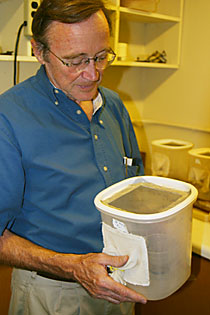 |
|
DAVID HARDEN/Arizona Daily Wildcat
|
Henry Hagedorn, an entomology researcher, examines mosquito specimens that are believed to carry the West Nile Virus. Hagedorn is working to find the source of the West Nile Virus to help prevent the spread of the disease.
|
|
By Stephanie Schwartz
Arizona Daily Wildcat
Thursday October 10, 2002
Birds and mosquitoes carrying the West Nile virus may be headed for Tucson and four UA researchers are learning everything they can to stop them.
Preliminary test results yesterday showed two Arizona residents who had returned from trips out of state were infected with the virus.
The researchers are from various departments, including entomology, and are working to prevent the spread of the virus to Arizona.
Although not usually fatal to humans, four people died from the West Nile virus in Louisiana earlier this year. Across the nation, 22 people have died from the virus since 1999, although many more were infected.
The researchers are looking to find which mosquitoes are here in Tucson, where they are and whom they are biting, said entomology professor Henry Hagedorn.
"We're also looking for mosquitoes that bite humans and birds," Hagedorn said. "Those will likely be the ones to transfer (the virus) to us."
The virus is a disease for mosquitoes and birds, and only occasionally affects humans. Bird migration in the winter spreads the disease from the East Coast to the rest of the country. Because Arizona is an important route for migrating birds, the arrival of the virus is likely to occur soon.
Only certain mosquitoes carry the virus, Hagedorn said. One possible carrier in Tucson is a small brown mosquito known as Culex quinquefasciapuf, which prefers to feed at dusk.
"If we know the type of mosquito that is the problem, we can tell people where to find them," Hagedorn said.
The veterinary sciences department is helping to detect outbreaks of the virus by studying chickens. Chickens are a good animal to use to study the virus because when they become infected they produce enough antibodies to usually prevent them from getting sick, said Woodson Tucker, research laboratory assistant for the veterinary sciences department.
There are six flocks of chickens in university-controlled areas that veterinary sciences researchers are studying in southeastern Arizona. Researchers collect blood from the chickens every two weeks and send it to a lab in Phoenix to test for antibodies for the West Nile virus, Tucker said.
"This tells us if the virus is present in the areas we're testing," Woodson said.
Hagedorn hopes that by the end of the year, they will be able to determine if the mosquitoes they catch have the virus.
The biggest issue is reducing mosquito-breeding sites, such as standing water, said Kathleen Walker, research associate for the Arizona research labs.
Because Tucson is so dry, most of the standing water Tucson residents have is man made, Walker said.
It's essential to take sensible precaution, such as not letting mosquito-breeding sites into homes, Walker said.
Female mosquitoes can lay eggs in water, and if it sits for a week or two, there is an infestation of mosquitoes that will then bite mammals, Walker said.
"The number one way to help is to dry up sources of breeding for mosquitoes," said Frank Ramberg, assistant research scientist in the entomology department. "It's not just for your yard; it is a neighborhood effort."
Ramberg suggests making sure screens are secure on all windows and wearing long pants when out between dusk and dawn.
Ceramic dishes put under flowerpots and pets' water bowls also attract mosquitoes, he said.
Different research groups are studying the Sam Hughes neighborhood in the blocks between North Campbell Avenue, East Speedway Boulevard, North Country Club Road and Broadway Boulevard to see if mosquito eggs are present.
The Associated Press contributed to this report.

